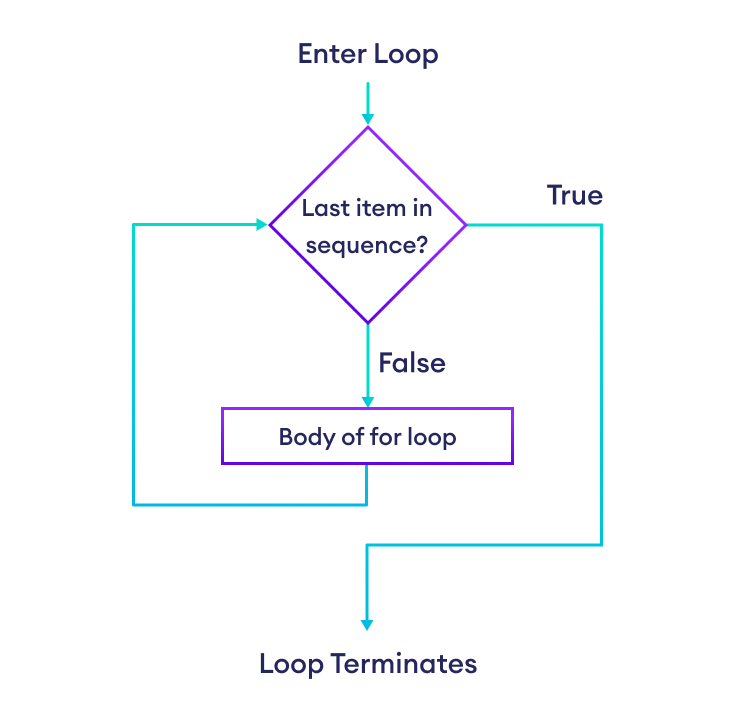In Python, a for loop is used to iterate over sequences such as lists, strings, tuples, etc.
languages = ['Swift', 'Python', 'Go']
# access elements of the list one by one
for i in languages:
print(i)
Output
Swift Python Go
In the above example, we have created a list called languages. As the list has 3 elements, the loop iterates 3 times.
The value of i is
Swiftin the first iteration.Pythonin the second iteration.Goin the third iteration.
for loop Syntax
for val in sequence:
# statement(s)
Here, val accesses each item of the sequence on each iteration. The loop continues until we reach the last item in the sequence.
Flowchart of Python for Loop

Example: Loop Through a String
language = 'Python'
# iterate over each character in language
for x in language:
print(x)
Output
P y t h o n
Here, we have printed each character of the string language using a for loop.
for Loop with Python range()
In Python, the range() function returns a sequence of numbers. For example,
values = range(4)
Here, range(4) returns a sequence of 0, 1, 2 ,and 3.
Since the range() function returns a sequence of numbers, we can iterate over it using a for loop. For example,
# iterate from i = 0 to i = 3
for i in range(4):
print(i)
Output
0 1 2 3
Here, we used the for loop to iterate over a range from 0 to 3.
This is how the above program works.
| Iteration | Value of i |
print(i) |
Last item in sequence? |
|---|---|---|---|
| 1st | 0 |
Prints 0 |
No |
| 2nd | 1 |
Prints 1 |
No |
| 3rd | 2 |
Prints 2 |
No |
| 4th | 3 |
Prints 3 |
Yes The loop terminates. |
More on Python for Loop
else clause
A for loop can have an optional else clause. This else clause executes after the iteration completes.
digits = [0, 1, 5]
for i in digits:
print(i)
else:
print("No items left.")
Output
0 1 5 No items left.
Here, the for loop prints all the items of the digits list. When the loop finishes, it executes the else block and prints No items left.
Note: The else block will not execute if the for loop is stopped by a break statement.
We can also use for loop to repeat an action a certain number of times. For example,
languages = ['Swift', 'Python', 'Go']
# looping to repeat an action without using the list elements
for language in languages:
print('Hi')
Output
Hi Hi Hi
Here, we used the list languages to run the loop three times. However, we didn't use any of the elements of the list.
In such cases, it is clearer to use the _ (underscore) as the loop variable. The _ indicates that a loop variable is a placeholder and its value is intentionally being ignored.
For example,
languages = ['Swift', 'Python', 'Go']
# using _ for placeholder variable
for _ in languages:
print('Hi')
Here, the loop still runs three times because there are three elements in the languages list. Using _ indicates that the loop is there for repetition and not for accessing the elements.
A for loop can also have another for loop inside it. For each cycle of the outer loop, the inner loop completes its entire sequence of iterations. For example,
# outer loop
for i in range(2):
# inner loop
for j in range(2):
print(f"i = {i}, j = {j}")
Output
i = 0, j = 0 i = 0, j = 1 i = 1, j = 0 i = 1, j = 1
Also Read: